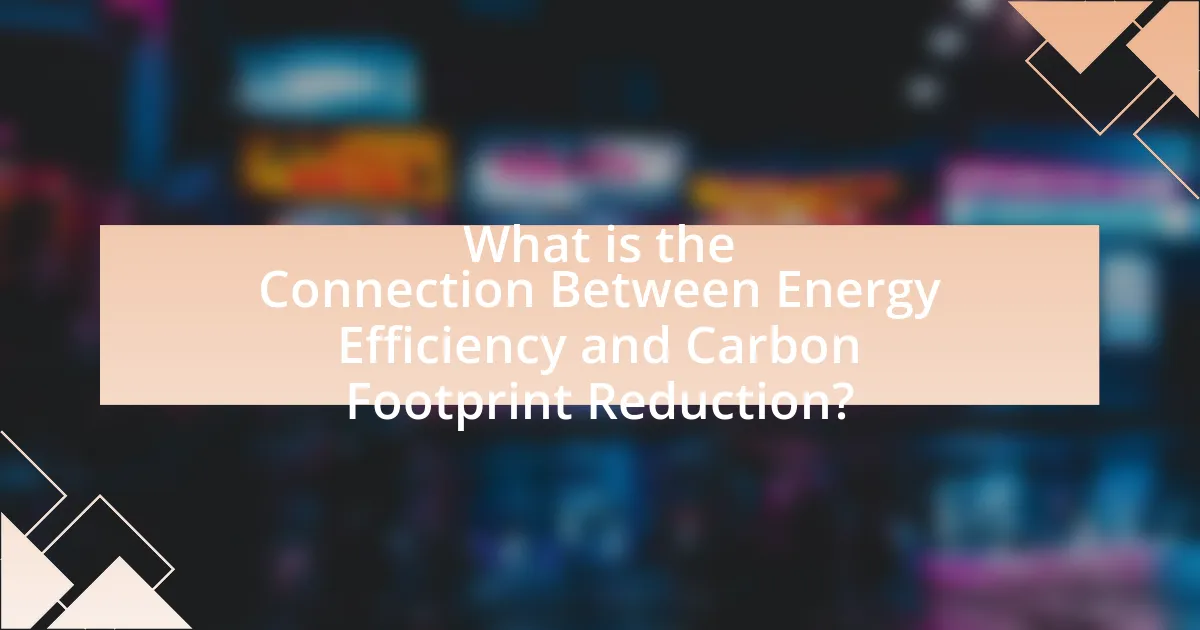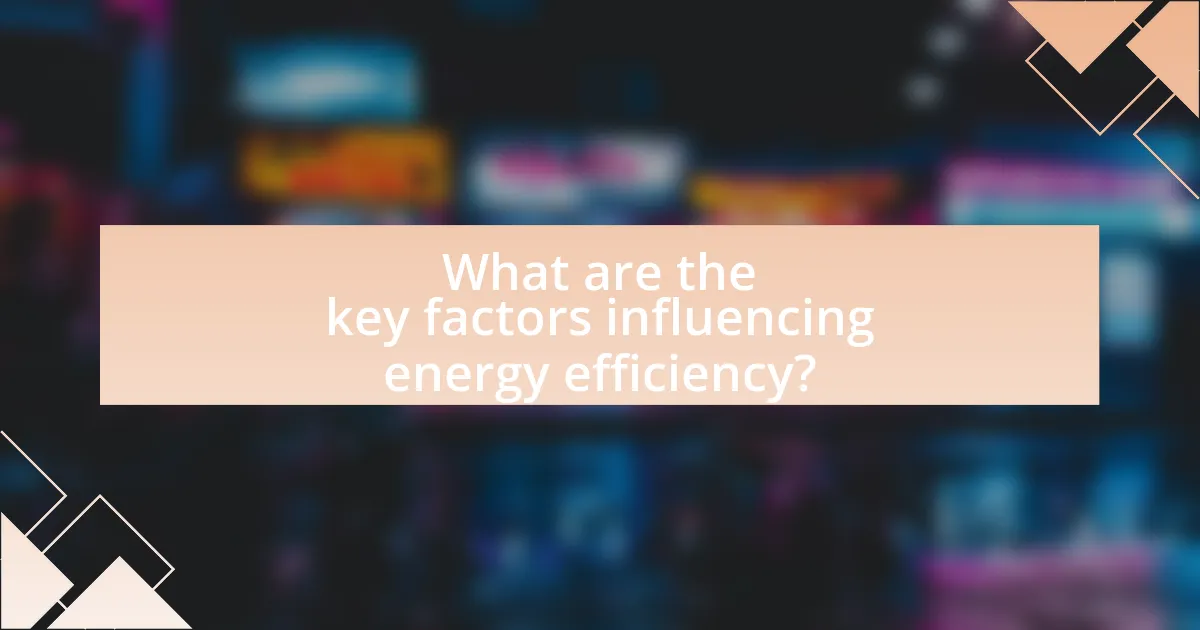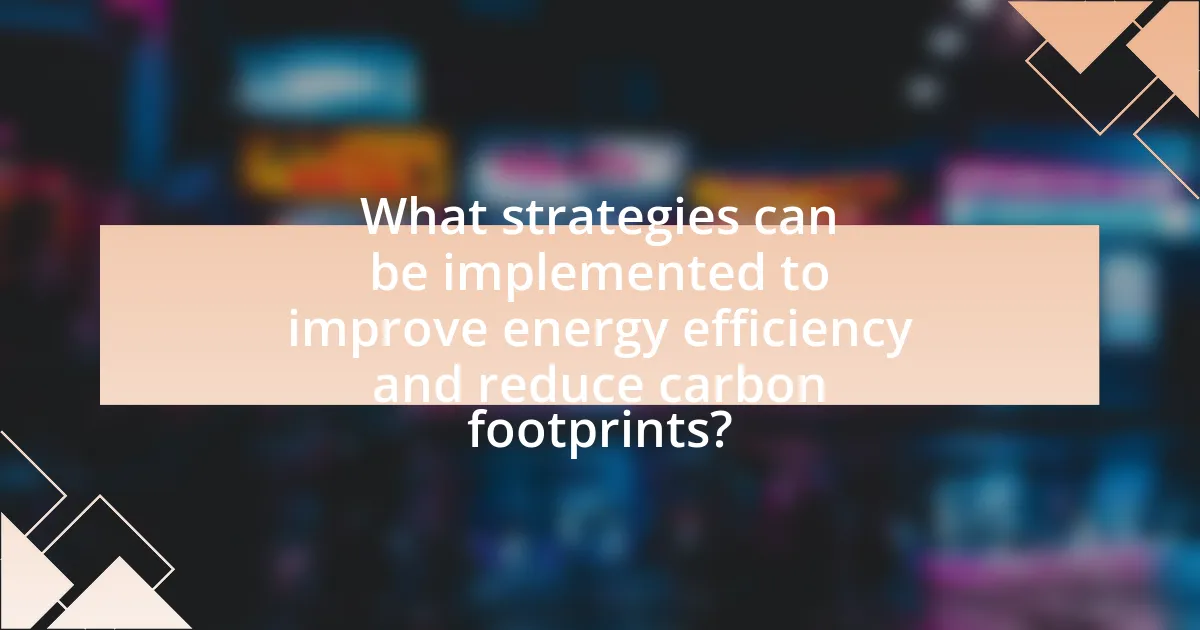The article examines the critical relationship between energy efficiency and carbon footprint reduction, highlighting how improved energy efficiency can significantly decrease greenhouse gas emissions. It discusses the mechanisms through which energy-efficient technologies and practices, such as LED lighting and high-efficiency appliances, contribute to lower energy consumption and reduced reliance on fossil fuels. The article also outlines the environmental impacts of high carbon footprints, the role of energy consumption in carbon emissions, and the importance of policies and regulations in promoting energy efficiency. Additionally, it provides practical strategies for individuals and organizations to enhance energy efficiency and mitigate climate change effectively.

What is the Connection Between Energy Efficiency and Carbon Footprint Reduction?
Energy efficiency directly reduces carbon footprints by minimizing the amount of energy required for various processes, thereby decreasing greenhouse gas emissions associated with energy production. When energy-efficient technologies and practices are implemented, such as LED lighting or high-efficiency appliances, they consume less electricity, which often comes from fossil fuel sources that emit carbon dioxide. According to the International Energy Agency, improving energy efficiency could account for over 40% of the reduction needed to meet global climate goals by 2040. This demonstrates that enhancing energy efficiency is a critical strategy for mitigating climate change and lowering overall carbon emissions.
How do energy efficiency and carbon footprint relate to each other?
Energy efficiency and carbon footprint are directly related, as improving energy efficiency typically leads to a reduction in carbon emissions. When energy is used more efficiently, less energy is required to perform the same tasks, which often results in lower fossil fuel consumption and, consequently, a decrease in greenhouse gas emissions. For instance, according to the U.S. Environmental Protection Agency, energy-efficient appliances can reduce energy use by 10-50%, significantly lowering the associated carbon footprint. Thus, enhancing energy efficiency is a critical strategy for mitigating climate change by reducing overall carbon emissions.
What role does energy consumption play in carbon emissions?
Energy consumption is a primary driver of carbon emissions, as the burning of fossil fuels for energy releases significant amounts of carbon dioxide into the atmosphere. According to the International Energy Agency, in 2021, energy-related carbon dioxide emissions reached a record high of 36.4 billion metric tons, largely due to increased energy demand and reliance on coal and oil. This relationship indicates that higher energy consumption, particularly from non-renewable sources, directly correlates with increased carbon emissions, exacerbating climate change.
How can improving energy efficiency lead to lower carbon footprints?
Improving energy efficiency leads to lower carbon footprints by reducing the amount of energy required for various processes, which in turn decreases greenhouse gas emissions associated with energy production. For instance, according to the U.S. Environmental Protection Agency, energy efficiency measures can reduce energy consumption by 20-30%, significantly lowering the demand for fossil fuels that contribute to carbon emissions. Additionally, the International Energy Agency reports that enhancing energy efficiency in buildings and industries can lead to a reduction of up to 1.7 gigatons of CO2 emissions annually. Thus, by using energy more effectively, less energy is consumed, resulting in a direct decrease in carbon emissions.
Why is understanding this connection important?
Understanding the connection between energy efficiency and carbon footprint reduction is crucial because it directly impacts environmental sustainability and climate change mitigation. Energy efficiency measures, such as improving insulation or using energy-efficient appliances, reduce the amount of energy consumed, which in turn lowers greenhouse gas emissions. According to the International Energy Agency, enhancing energy efficiency could account for over 40% of the necessary reductions in global carbon emissions by 2040. This relationship underscores the importance of adopting energy-efficient practices to achieve significant environmental benefits and combat climate change effectively.
What are the environmental impacts of high carbon footprints?
High carbon footprints significantly contribute to climate change, leading to severe environmental impacts such as rising global temperatures, extreme weather events, and loss of biodiversity. The Intergovernmental Panel on Climate Change (IPCC) reports that human activities, particularly fossil fuel combustion, have increased atmospheric carbon dioxide levels by over 40% since the pre-industrial era, resulting in a 1.1°C rise in global temperatures. This temperature increase is linked to more frequent and intense hurricanes, droughts, and floods, which disrupt ecosystems and threaten species extinction. Additionally, high carbon emissions contribute to ocean acidification, adversely affecting marine life and coral reefs, which are vital for biodiversity and coastal protection.
How does energy efficiency contribute to sustainability goals?
Energy efficiency significantly contributes to sustainability goals by reducing energy consumption and minimizing greenhouse gas emissions. When energy-efficient technologies and practices are implemented, they lower the demand for energy production, which is often reliant on fossil fuels. For instance, according to the International Energy Agency, improving energy efficiency could account for over 40% of the necessary reductions in global carbon emissions by 2040. This reduction in energy use not only conserves resources but also leads to lower operational costs for businesses and households, promoting economic sustainability. Furthermore, energy efficiency initiatives can enhance energy security by decreasing reliance on imported fuels, thereby supporting a more resilient energy system.

What are the key factors influencing energy efficiency?
The key factors influencing energy efficiency include technology, building design, user behavior, and regulatory policies. Technology advancements, such as high-efficiency appliances and smart energy management systems, significantly enhance energy efficiency by reducing consumption. Building design plays a crucial role; structures that utilize natural light and proper insulation can minimize energy use. User behavior, including habits like turning off lights and optimizing thermostat settings, directly impacts energy consumption levels. Regulatory policies, such as energy efficiency standards and incentives for renewable energy use, further drive improvements in energy efficiency. For instance, the U.S. Department of Energy reports that implementing energy-efficient technologies can reduce energy consumption by up to 30%.
How do technology and innovation enhance energy efficiency?
Technology and innovation enhance energy efficiency by introducing advanced systems and processes that optimize energy use and reduce waste. For instance, smart grids utilize real-time data to manage electricity distribution more effectively, leading to a reduction in energy loss during transmission. Additionally, energy-efficient appliances, such as those meeting ENERGY STAR standards, consume significantly less energy compared to traditional models; for example, ENERGY STAR certified products use about 10-50% less energy. Furthermore, innovations in building materials, like insulated windows and energy-efficient HVAC systems, contribute to lower energy consumption in residential and commercial buildings. These advancements collectively lead to a measurable decrease in energy demand and a corresponding reduction in carbon emissions, aligning with sustainability goals.
What are the latest advancements in energy-efficient technologies?
The latest advancements in energy-efficient technologies include the development of smart grids, advanced energy storage systems, and high-efficiency appliances. Smart grids utilize digital technology to optimize electricity distribution, reducing energy waste and enhancing reliability. Advanced energy storage systems, such as lithium-ion batteries and flow batteries, allow for better integration of renewable energy sources, enabling more efficient energy use. High-efficiency appliances, including LED lighting and Energy Star-rated devices, consume significantly less energy compared to traditional models, contributing to lower overall energy consumption. These advancements collectively support the reduction of carbon footprints by minimizing energy waste and promoting sustainable energy practices.
How do smart systems contribute to energy savings?
Smart systems contribute to energy savings by optimizing energy consumption through real-time data analysis and automation. These systems, such as smart thermostats and energy management software, adjust energy usage based on occupancy patterns and environmental conditions, leading to reduced waste. For instance, a study by the American Council for an Energy-Efficient Economy found that smart thermostats can save homeowners an average of 10-12% on heating and cooling costs annually. This optimization not only lowers energy bills but also decreases the overall carbon footprint associated with energy production and consumption.
What role do policies and regulations play in promoting energy efficiency?
Policies and regulations are crucial in promoting energy efficiency by establishing standards and incentives that encourage reduced energy consumption. For instance, energy efficiency standards for appliances and buildings, such as the Energy Star program in the United States, mandate minimum efficiency levels, leading to significant reductions in energy use. According to the U.S. Department of Energy, these standards have saved consumers over $450 billion on energy bills since their inception. Additionally, regulations such as tax credits and rebates for energy-efficient upgrades motivate businesses and homeowners to invest in energy-saving technologies, further enhancing overall energy efficiency and contributing to carbon footprint reduction.
What are some examples of effective energy efficiency policies?
Effective energy efficiency policies include building codes that mandate energy-saving standards, energy efficiency labeling programs for appliances, and financial incentives such as tax credits for energy-efficient upgrades. For instance, the Energy Star program in the United States has led to significant reductions in energy consumption by promoting energy-efficient products, resulting in savings of over $500 billion on utility bills since its inception. Additionally, the European Union’s Energy Efficiency Directive aims to achieve a 32.5% improvement in energy efficiency by 2030, demonstrating a commitment to reducing carbon emissions through structured policy frameworks.
How do government incentives impact energy efficiency initiatives?
Government incentives significantly enhance energy efficiency initiatives by providing financial support and regulatory frameworks that encourage investment in energy-saving technologies. These incentives, such as tax credits, rebates, and grants, lower the upfront costs for businesses and homeowners, making energy-efficient upgrades more accessible. For instance, a study by the American Council for an Energy-Efficient Economy found that states with robust energy efficiency programs, often supported by government incentives, achieved energy savings of up to 20% compared to those without such programs. This demonstrates that government incentives not only stimulate the adoption of energy-efficient practices but also contribute to substantial reductions in energy consumption and associated carbon emissions.

What strategies can be implemented to improve energy efficiency and reduce carbon footprints?
Implementing strategies such as upgrading to energy-efficient appliances, enhancing insulation, and utilizing renewable energy sources can significantly improve energy efficiency and reduce carbon footprints. For instance, replacing traditional incandescent bulbs with LED lighting can reduce energy consumption by up to 75%, according to the U.S. Department of Energy. Additionally, improving building insulation can lower heating and cooling costs by 20% to 30%, as reported by the Environmental Protection Agency. Transitioning to renewable energy sources like solar or wind can further decrease reliance on fossil fuels, which are major contributors to carbon emissions. These strategies collectively contribute to a more sustainable energy system and lower greenhouse gas emissions.
What are the best practices for businesses to enhance energy efficiency?
Businesses can enhance energy efficiency by implementing energy management systems, upgrading to energy-efficient equipment, and promoting employee awareness and engagement. Energy management systems allow businesses to monitor and optimize energy use, leading to significant reductions in consumption. Upgrading to energy-efficient equipment, such as LED lighting and high-efficiency HVAC systems, can reduce energy use by 20-50%, according to the U.S. Department of Energy. Additionally, fostering a culture of energy awareness among employees can lead to behavioral changes that further reduce energy consumption, as studies show that engaged employees can contribute to a 10-15% decrease in energy use.
How can companies conduct energy audits effectively?
Companies can conduct energy audits effectively by following a structured approach that includes assessing energy consumption, identifying inefficiencies, and implementing corrective measures. This process typically begins with gathering data on energy usage across all operations, which can be achieved through utility bills, energy management systems, and on-site inspections.
Next, companies should analyze this data to pinpoint areas of excessive energy use, such as outdated equipment or inefficient processes. For instance, the U.S. Department of Energy reports that energy audits can lead to energy savings of 5% to 30% by identifying these inefficiencies.
After identifying problem areas, companies should prioritize improvements based on cost-effectiveness and potential energy savings. Implementing energy-efficient technologies, such as LED lighting or high-efficiency HVAC systems, can significantly reduce energy consumption and, consequently, carbon emissions.
Finally, companies should establish a monitoring system to track the effectiveness of the implemented changes and ensure continuous improvement. Regular follow-up audits can help maintain energy efficiency and adapt to any changes in operations or technology.
What measures can be taken to optimize energy use in operations?
To optimize energy use in operations, organizations can implement energy management systems that monitor and control energy consumption. These systems enable real-time tracking of energy usage, allowing for the identification of inefficiencies and the implementation of corrective measures. For instance, a study by the U.S. Department of Energy found that companies using energy management systems can reduce energy consumption by 10-30%, significantly lowering operational costs and carbon emissions. Additionally, adopting energy-efficient technologies, such as LED lighting and high-efficiency HVAC systems, further enhances energy savings and contributes to a reduced carbon footprint.
How can individuals contribute to energy efficiency and carbon footprint reduction?
Individuals can contribute to energy efficiency and carbon footprint reduction by adopting sustainable practices in their daily lives. Actions such as using energy-efficient appliances, reducing water usage, and utilizing public transportation can significantly lower energy consumption and greenhouse gas emissions. For instance, replacing incandescent bulbs with LED lights can reduce energy use by up to 75%, according to the U.S. Department of Energy. Additionally, reducing meat consumption and increasing plant-based diets can lower an individual’s carbon footprint, as livestock production is a major source of methane emissions. By making conscious choices in energy use and consumption habits, individuals can play a crucial role in mitigating climate change.
What lifestyle changes can lead to significant energy savings?
Adopting energy-efficient habits can lead to significant energy savings. Key lifestyle changes include using energy-efficient appliances, which can reduce energy consumption by 10-50% compared to standard models. Additionally, implementing smart home technology, such as programmable thermostats, can optimize heating and cooling, resulting in up to 30% savings on energy bills.
Reducing water heater temperature to 120 degrees Fahrenheit can save 3-5% on energy costs for every 10 degrees lowered. Furthermore, utilizing public transportation, carpooling, or biking can decrease reliance on fossil fuels, contributing to lower overall energy use.
According to the U.S. Department of Energy, these changes not only save money but also significantly reduce carbon emissions, aligning with efforts to mitigate climate change.
How can consumers make informed choices about energy use?
Consumers can make informed choices about energy use by evaluating energy efficiency ratings, understanding their energy consumption patterns, and utilizing available tools and resources. Energy efficiency ratings, such as those provided by ENERGY STAR, indicate how well appliances and products use energy compared to others, helping consumers select options that reduce energy consumption. Additionally, monitoring personal energy usage through smart meters or energy tracking apps allows consumers to identify high-consumption areas and adjust their habits accordingly. Research shows that informed consumers can reduce their energy use by 10-30% simply by being aware of their consumption and making conscious choices.
What are the common challenges faced in achieving energy efficiency?
Common challenges faced in achieving energy efficiency include high upfront costs, lack of awareness, and insufficient incentives. High upfront costs deter individuals and organizations from investing in energy-efficient technologies, as initial investments can be significant. Lack of awareness about the benefits and availability of energy-efficient options leads to underutilization of these technologies. Additionally, insufficient incentives from governments or utilities can limit motivation for adopting energy-efficient practices, as financial benefits may not be compelling enough to drive change. According to the International Energy Agency, these barriers significantly hinder progress toward energy efficiency goals globally.
What barriers do organizations encounter when implementing energy-efficient practices?
Organizations encounter several barriers when implementing energy-efficient practices, including high initial costs, lack of expertise, and resistance to change. High initial costs deter many organizations from investing in energy-efficient technologies, as upfront expenses can be significant despite long-term savings. Additionally, a lack of expertise in energy management and technology can hinder effective implementation, as organizations may not have the necessary knowledge to identify and adopt suitable practices. Resistance to change within organizational culture can also pose a challenge, as employees and management may be reluctant to alter established processes or invest time in new initiatives. These barriers collectively impede the transition to energy-efficient practices, which are essential for reducing carbon footprints.
How can these challenges be overcome effectively?
To overcome challenges in enhancing energy efficiency and reducing carbon footprints effectively, implementing advanced technologies such as smart grids and energy management systems is essential. These technologies optimize energy use, reduce waste, and facilitate the integration of renewable energy sources. For instance, a study by the International Energy Agency indicates that smart grid technologies can reduce energy consumption by up to 30% in urban areas, significantly lowering carbon emissions. Additionally, promoting energy-efficient practices through policy incentives and public awareness campaigns can drive behavioral changes among consumers and businesses, further contributing to carbon footprint reduction.
What practical steps can be taken to start reducing carbon footprints today?
To start reducing carbon footprints today, individuals can implement energy-efficient practices such as using LED lighting, which consumes up to 75% less energy than traditional incandescent bulbs. Additionally, reducing vehicle use by opting for public transportation, biking, or walking can significantly lower carbon emissions; for instance, public transit can reduce greenhouse gas emissions by 45% per mile compared to single-occupancy vehicles. Furthermore, adopting a plant-based diet can decrease an individual’s carbon footprint by up to 50%, as livestock production is a major contributor to greenhouse gas emissions. These practical steps are supported by research indicating that energy efficiency and lifestyle changes directly correlate with reduced carbon emissions.